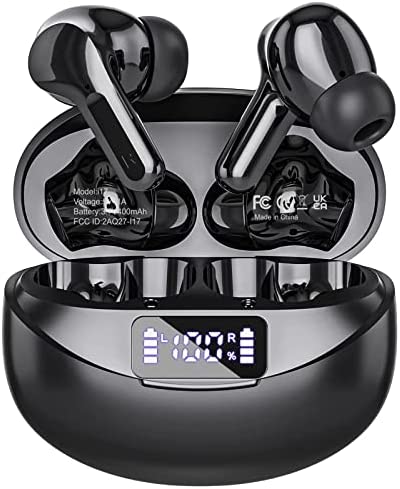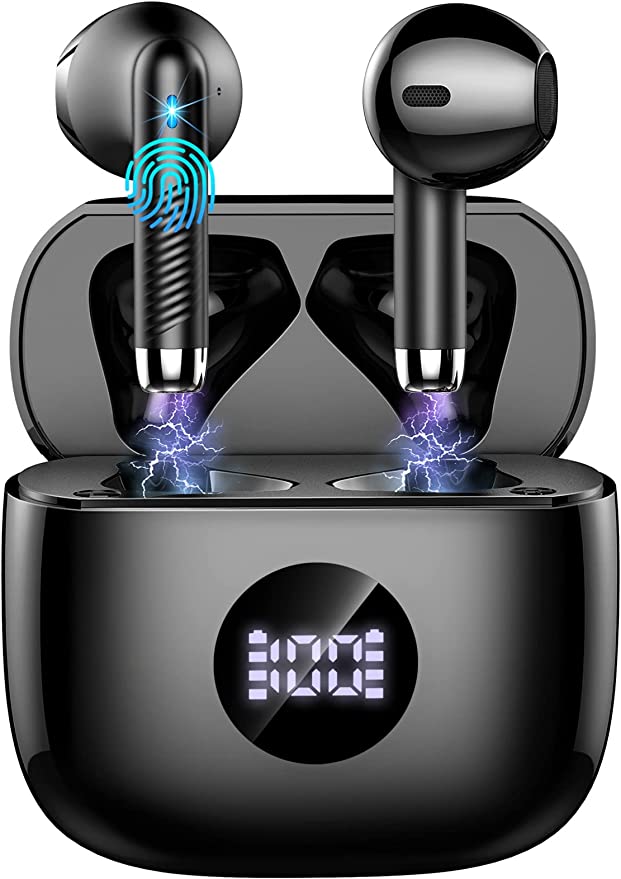You’re in the zone. The pavement pounds beneath your feet, your heart rate is up, and the music pulsing in your ears fuels every stride. Then, disaster strikes. That familiar, frustrating wiggle, followed by an earbud tumbling free, bouncing onto the path. Or perhaps it’s the creeping fear that the steady drip of sweat might silence your soundtrack for good. Finding workout earbuds that can genuinely keep up – staying secure, shrugging off moisture, and delivering decent sound without costing a fortune – is a common quest for fitness enthusiasts.
Enter the ZZN ZT02 wireless earbuds. Sporting a $29.99 price tag and features explicitly aimed at the active user, they present themselves as a potential solution. But beyond the marketing claims, what real engineering and scientific principles are at play? Can accessible technology truly meet the demanding needs of a workout? Let’s peel back the layers and explore the science packed into these sport-focused earbuds, examining how they tackle the core challenges of exercise.

The Physics of Fit: Engineering Stability Against Motion
The first hurdle any workout earbud must clear is the relentless assault of physics. Gravity constantly pulls downwards, while the dynamic movements of running, jumping, or weightlifting introduce complex inertial forces trying to pry the earbuds loose. It’s a battle against basic mechanics.
The most visible weapon in the ZZN ZT02’s arsenal against this is the soft earhook design. Think of it like the arm of a pair of glasses. This flexible hook loops over the superior part of your ear (the pinna), creating an essential anchor point. From a physics perspective, it acts as a lever, counteracting the downward pull and the jostling forces generated by your movement. This aims to provide what the manufacturer describes as an “unshakable fit,” crucial for uninterrupted focus during exercise.
But the hook is only half the equation for stability. The other critical element is the seal created by the ear tip inside your ear canal. A snug, comfortable seal does more than just passively sit there; it actively contributes to stability by increasing the contact area and friction within the ear. Furthermore, this seal is paramount for audio quality, particularly bass reproduction. Sound waves, especially low-frequency ones, need a sealed chamber to build pressure and deliver impact. A poor seal means bass leaks out, resulting in thin, unsatisfying sound.
Recognizing that ears come in a vast array of shapes and sizes, ZZN includes four pairs of silicone ear tips (one Small, one Medium, and two Large). Finding the size that creates a secure yet comfortable seal is non-negotiable for maximizing both stability and the perceived sound quality. It’s this combination of the over-ear anchor and the in-ear seal that allows users to rate the comfort at a respectable 4.1 out of 5, suggesting the design generally succeeds in balancing security with wearability for many. Imagine sprinting for that final push or powering through a set of burpees – the goal is for these earbuds to feel like a natural extension of you, not a precarious accessory.

Water, Water Everywhere: The Science of Surviving Sweat and Rain
The next formidable foe for workout electronics is moisture. Sweat, rain, even high humidity can wreak havoc on sensitive internal components, leading to corrosion, short circuits, and ultimately, failure. This is where material science and engineering seals come into play.
The ZZN ZT02 boasts an IPX7 waterproof rating. Let’s decode that alphanumeric soup. “IP” stands for Ingress Protection, an international standard (IEC 60529) that classifies the degree of protection provided by an enclosure against intrusion from foreign objects (the ‘X’ means it’s not rated for dust/solid ingress) and liquids (the ‘7’). An IPX7 rating specifically signifies that the device can withstand temporary immersion in water up to 1 meter (about 3.3 feet) deep for a duration of 30 minutes under controlled laboratory conditions.
How is this achieved? Generally, manufacturers employ a combination of strategies. This often involves precision-engineered seams and gaskets to physically block water entry, much like the seals on a diver’s watch. Additionally, hydrophobic nano-coatings are frequently applied to the internal circuitry. Think of these coatings as an invisible shield that actively repels water molecules at a microscopic level, preventing them from adhering to and damaging sensitive components. It’s like treating a rain jacket with a water-repellent spray, but on a much finer scale.
This IPX7 rating provides significant peace of mind. It means you can likely push through a grueling, sweat-drenched workout or get caught in an unexpected downpour without frying your earbuds. However, it’s crucial to heed the manufacturer’s explicit clarification: these are “(not for swimming)”. The IPX7 test involves static immersion in fresh water. The dynamic pressure changes, chlorine, or saltwater encountered during swimming are entirely different beasts and could compromise the seals. So, while they’re built to handle the rigors of land-based workouts and inclement weather, keep them out of the pool. User feedback occasionally mentions perceived discrepancies between the IP rating and included literature, highlighting the importance of understanding the _practical_ limits defined by the manufacturer alongside the technical standard.

Sound Waves in Motion: Delivering Audio for the Active Soul
While fit and durability are crucial, the core purpose remains delivering motivating audio. The ZZN ZT02 houses an 11mm Diamond-Like Carbon (DLC) dynamic driver in each earbud. Let’s break that down. A dynamic driver works much like a miniature conventional loudspeaker: an electrical audio signal energizes a voice coil attached to a diaphragm, causing the diaphragm to vibrate rapidly. These vibrations move the air, creating the sound waves that travel down your ear canal to your eardrum.
The 11mm driver size is relatively large for earbuds. Theoretically, a larger diaphragm can move more air, which is often associated with the potential for stronger bass response – the “Punchy Bass” ZZN claims. The diaphragm material itself, Diamond-Like Carbon (DLC), is interesting. DLC is known for its high stiffness-to-weight ratio. In audio engineering, a stiff yet lightweight diaphragm is desirable because it can potentially vibrate accurately at high frequencies without flexing or distorting (leading to clearer treble) and respond quickly to changes in the audio signal (improving overall detail and transient response).
However, translating driver specifications into real-world listening experience isn’t always direct. While ZZN claims “Punchy Bass” and “Real Immersive” sound, the user sound quality rating averages 3.9 out of 5 stars, indicating a more moderate reception. Some user reviews echo the “good bass” sentiment, while others explicitly mention a lack of it. This highlights the subjective nature of audio perception and the critical role of achieving that proper ear tip seal – without it, even the most capable driver will sound weak in the low end.
_(Self-correction note: The initial product description mentions “hybrid dual-dynamic and balanced armature drivers,” but further details heavily emphasize the 11mm DLC driver. Without more specifics on the hybrid setup, focusing the scientific explanation on the more detailed and likely primary driver component – the 11mm DLC dynamic driver – provides a more verifiable and less speculative analysis based on the provided text.)_

Wireless Freedom & Fingertip Control: The User Experience
Beyond sound and resilience, usability during exercise is key. Seamless connectivity and easy controls are vital when you’re focused on your form or pushing your limits.
The ZZN ZT02 uses Bluetooth 5.0 for its wireless connection. Compared to older Bluetooth versions, 5.0 offers potential improvements in data transfer speed and connection stability, aiming for that “unbreakable connection” (though real-world mileage can vary – some users report generally stable connections with occasional need to reseat the earbuds). It supports essential audio profiles like A2DP (Advanced Audio Distribution Profile), enabling stereo music streaming. The earbuds also feature Auto Pairing, meaning after the initial setup, they should automatically power on and connect to your device when removed from the charging case – a small convenience that adds up.
Critically for sports use, ZZN opted for physical button controls (MFB – Multi-function Button) instead of touch controls. While touch controls can feel sleek, they can be frustrating during workouts. Sweaty fingers, accidental touches while adjusting fit, or even wearing gloves can lead to unintended pauses, skips, or volume changes. Physical buttons provide definite tactile feedback – you _know_ when you’ve pressed it. This simple, perhaps less “modern” choice, often proves more practical and reliable when you’re on the move and can’t afford distractions. These buttons handle typical functions: play/pause, track skipping, call management, and activating your phone’s voice assistant.
Adding to flexibility is the Mono Mode. This allows you to use either the left or right earbud independently while the other stays in the case. It’s useful for situations where you need to maintain awareness of your surroundings (like running on busy streets) or simply want to extend battery life by alternating earbuds.

Endurance Athletes: Powering Your Playlist Marathon
Few things kill workout motivation faster than earbuds dying mid-session. Battery life is a major consideration, and here the ZZN ZT02 appears to perform strongly, reflected in its high 4.8 out of 5 battery life rating from users.
The earbuds themselves offer up to 6 hours of playtime on a single charge, generally sufficient for most individual workouts or even longer endurance sessions. The real powerhouse, however, is the charging case. It stores additional charge, capable of replenishing the earbuds multiple times, extending the total listening time to around 30 hours according to the product description. This means you could potentially go through a full week of regular workouts without needing to plug the case itself in. When it does need charging, it utilizes a modern and convenient USB-C port.
User feedback does highlight a couple of quirks typical of many true wireless earbuds in this category: the earbuds generally only power off when placed back into the case, and the case’s remaining charge level might only be clearly indicated when it’s actively being charged. These are minor usability points but worth noting for managing expectations.

Conclusion: Sound Science for the Everyday Athlete
The ZZN ZT02 wireless earbuds serve as a practical case study in applying fundamental scientific and engineering principles to create an accessible product tailored for a specific need. They don’t aim to be audiophile marvels or packed with cutting-edge, exotic features. Instead, they focus on executing the essentials for sport use: achieving a stable fit through ergonomic earhooks and customizable tips (physics and ergonomics), surviving inevitable moisture via IPX7 rating (material science and standardized sealing), delivering sound through a sizable DLC dynamic driver (acoustics), ensuring reliable Bluetooth 5.0 connectivity and practical button controls (wireless tech and HCI), and providing impressive battery endurance.
While user feedback points to some variability, particularly in sound perception and occasional connectivity hiccups, the overall package seems to deliver on its core promises for many users, especially considering its $29.99 price point. The ZZN ZT02 demonstrates how thoughtful design choices, grounded in established science, can bring crucial sport-specific features – stability, water resistance, long battery life – within reach, empowering more people to enjoy their workouts with a reliable audio companion. It’s a testament to the ongoing democratization of technology, where good enough, purpose-built performance becomes increasingly attainable.




